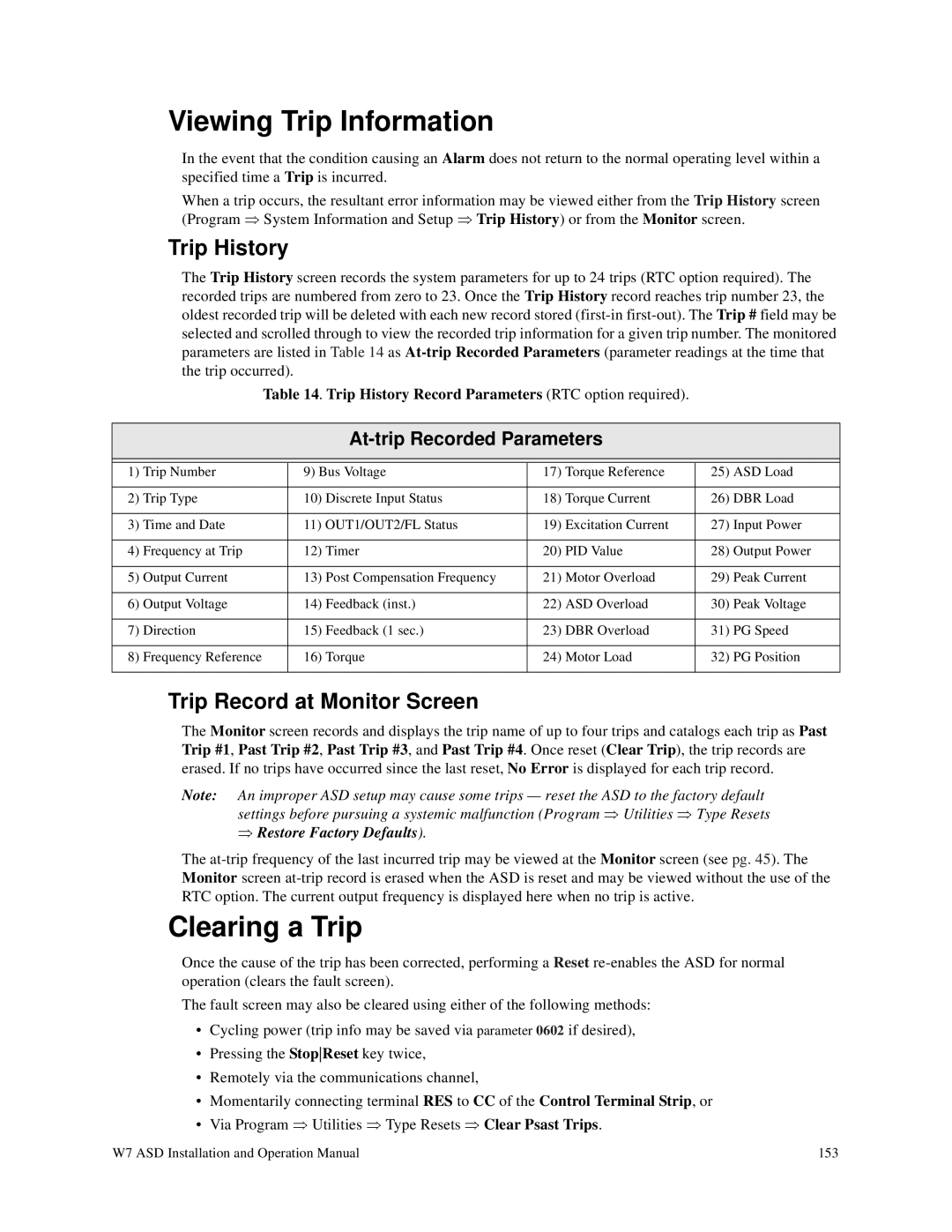
Viewing Trip Information
In the event that the condition causing an Alarm does not return to the normal operating level within a specified time a Trip is incurred.
When a trip occurs, the resultant error information may be viewed either from the Trip History screen
(Program System Information and Setup | Trip History) or from the Monitor screen. |
⇒ | ⇒ |
Trip History |
|
The Trip History screen records the system parameters for up to 24 trips (RTC option required). The recorded trips are numbered from zero to 23. Once the Trip History record reaches trip number 23, the oldest recorded trip will be deleted with each new record stored
Table 14. Trip History Record Parameters (RTC option required).
At-trip Recorded Parameters
1) | Trip Number | 9) Bus Voltage | 17) | Torque Reference | 25) | ASD Load | |
|
|
|
|
|
|
|
|
2) | Trip Type | 10) | Discrete Input Status | 18) | Torque Current | 26) | DBR Load |
|
|
|
|
|
|
| |
3) | Time and Date | 11) OUT1/OUT2/FL Status | 19) | Excitation Current | 27) | Input Power | |
|
|
|
|
|
|
|
|
4) | Frequency at Trip | 12) | Timer | 20) | PID Value | 28) | Output Power |
|
|
|
|
|
|
|
|
5) | Output Current | 13) | Post Compensation Frequency | 21) | Motor Overload | 29) | Peak Current |
|
|
|
|
|
|
|
|
6) | Output Voltage | 14) | Feedback (inst.) | 22) | ASD Overload | 30) | Peak Voltage |
|
|
|
|
|
|
|
|
7) | Direction | 15) | Feedback (1 sec.) | 23) | DBR Overload | 31) | PG Speed |
|
|
|
|
|
|
|
|
8) | Frequency Reference | 16) | Torque | 24) | Motor Load | 32) | PG Position |
|
|
|
|
|
|
|
|
Trip Record at Monitor Screen
The Monitor screen records and displays the trip name of up to four trips and catalogs each trip as Past Trip #1, Past Trip #2, Past Trip #3, and Past Trip #4. Once reset (Clear Trip), the trip records are erased. If no trips have occurred since the last reset, No Error is displayed for each trip record.
Note: An improper ASD setup may cause some trips — reset the ASD to the factory default
settings before pursuing a systemic malfunction (Program | Utilities | Type Resets |
Restore Factory Defaults). |
|
|
The
Clearing a Trip
Once the cause of the trip has been corrected, performing a Reset
The fault screen may also be cleared using either of the following methods:
• | Cycling power (trip info may be saved via parameter 0602 if desired), |
| ||||
• | Pressing the StopReset key twice, |
|
|
| ||
• | Remotely via the communications channel, |
|
|
| ||
• | Momentarily connecting terminal RES to CC of the Control Terminal Strip, or |
| ||||
• | Via Program | Utilities | Type Resets | Clear Psast Trips. | ⇒⇒ |
|
W7 ASD Installation and⇒Operation⇒Manual ⇒⇒ |
| 153 | ||||
